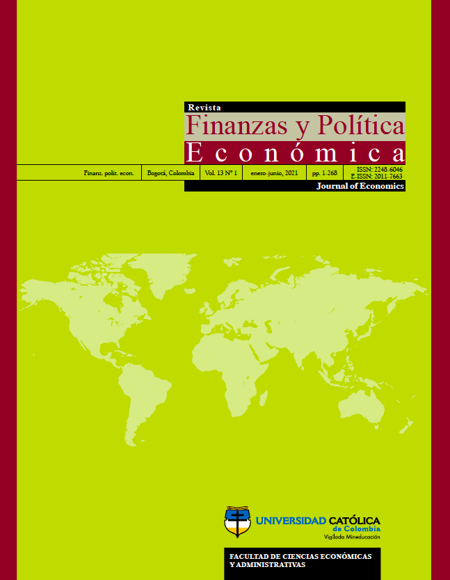This journal is licensed by a Creative Commons Attribution License (CC BY-NC-SA 4.0) Attribution-Non Commercial 4.0 International. For the CC licenses, the principle isthe creative freedom. This system complements the copyright without opposing it, conscious of its importance in our culture. The content of the articles is the responsibility of each author, and does not compromise in any way, to the journal or the university. It allows the transmission and reproduction of titles, abstracts and full content, with academic, scientific, cultural ends, provided acknowledgment of the respective source. This work cannot be used for commercial purposes.
They journal does not charge authors for submission or publication.
Abstract
Colombia, Mexico, and Peru) will have an economic recovery in 2021, as evidenced by increases in their respective gross domestic products (GDP). Furthermore, it argues that it is possible to calculate both production decline for those countries during 2020 and recovery reported for the following year. The corresponding calculations were based on economic and socio-political contexts that influenced the measures adopted in the four PA countries in face of the COVID-19 pandemic; in particular, measures that began in early March 2020. The greatest economic reactivation would happen in Mexico, although it is noteworthy that this particular result is closely related to the performance of the US economy, which acts as a natural market for the aforementioned Latin American country.

References
Alexander, C. y Herrador, S. (2020, 14 de mayo). Proyecciones de la actividad económica de Chile. https://www2.deloitte.com/cl/es/blog/insights-economicos/2020/resumen-de-la-actividad-economica.html
Asteriou D. y Hall S. G. (2011). Applied econometrics. Londres: Palgrave Macmillan.
Banco Mundial. (2020, 12 de abril). Informe semestral de la región América Latina y el Caribe, La economía en los tiempos del COVID-19. https://openknowledge.worldbank.org/bitstream/handle/10986/33555/211570SP.pdf
Banco Mundial. (2020, 13 de octubre). Perú: Panorama general. https://www.bancomundial.org/es/country/peru/overview
Banco Mundial. (2020). Indicadores del Banco Mundial. https://data.worldbank.org/indicator
Comisión Económica para América Latina y el Caribe (CEPAL). (2020a). Panorama regional de América Latina y el Caribe: indicadores seleccionados. https://estadisticas.cepal.org/cepalstat/
Comisión Económica para América Latina y el Caribe (CEPAL). (2020b, 21 de abril). Dimensionar los efectos del COVID-19 para pensar en la reactivación. https://repositorio.cepal.org/bitstream/handle/11362/45445/4/S2000286_es.pdf
Comisión Económica para América Latina y el Caribe (CEPAL). (2020c, 3 de abril). América Latina y el Caribe ante la pandemia del COVID-19: Efectos económicos y sociales. https://repositorio.cepal.org/bitstream/handle/11362/45337/4/S2000264_es.pdf
Gujarati, D. N. y Porter, D. C. (2010). Econometría. Ciudad de México: McGraw-Hill.
INFOBAE. (2020, 2 de abril). El complicado panorama económico para México en 2020: estiman crecimiento entre -3.9 y 0.1%. https://www.infobae.com/america/mexico/2020/04/02/el-complicado-panorama-economico-para-mexico-en-2020-en-el-mejor-de-los-casos-creceria-01/
Marascuilo, L. A. y Serlin, R. C. (1998). Statistical Methods for the Social and Behavioral Sciences. Goshen: W H Freeman & Co.
Portafolio. (2020, 26 de junio). FMI prevé un hundimiento de la economía colombiana en 2020. https://www.portafolio.co/internacional/noticias-coronavirus-fmi-preve-hundimiento-economia-colombiana-en-2020-542138
Programa de las Naciones Unidas para el Desarrollo (PNUD). (2020). Índices e indicadores del PNUD. http://hdr.undp.org/en/content/human-development-indices-and-indicators
Reyes, G. (2006). América Latina y el Caribe: integración e inserción en los mercados internacionales. Nómadas, Revista Crítica de Ciencias Sociales y Jurídicas, 14(2), 307-330.
Reyes, G. (2009). Desafíos macroeconómicos y desarrollo: consideraciones desde América Latina. Revista de Ciencias Sociales, 15(3), 383-396.
Samuelson, P. A. y Nordhaus, W. D. (2006). Economía. En P. A. Samuelson y W. D. Nordhaus, Economía. Madrid: McGraw-Hill.
Téllez, A. M. (2009, 11 de agosto). La mecánica cuántica. http://la-mecanica-cuantica.blogspot.com/2009/08/polinomios-de-legendre-aspectos.html
Wooldridge, J. M. (2009). Introducción a la econometría un enfoque moderno. Ciudad de México: McGraw-Hill. https://openknowledge.worldbank.org/bitstream/handle/10986/33555/211570SP.pdf





























